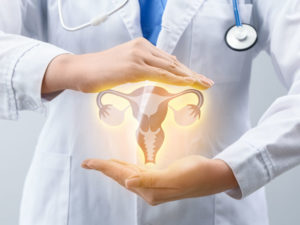If you’re a woman, you can run but you can’t hide from menopause! It’s a natural part of growing older. And if you’re experiencing menopausal symptoms – whether naturally or due to a hysterectomy – you know they can burden your quality of life if not treated.
Worse, if you’re having an early menopause or have had a hysterectomy, those embarrassing hot flashes and uncomfortable night sweats may arrive earlier than the average age of 51.
But the good news is, there are treatments to cope with symptoms and live well with your menopause at any age. Among those is bioidentical hormone replacement therapy.
In this article, we’ll cover the benefits and possible risks of BHRT after hysterectomy. We’ll also look at what happens in your body during natural or surgical menopause and some of the main menopause symptoms.
- Natural Menopause vs. Surgical Menopause
- What is a Hysterectomy?
- Why Do Some Women Need a Hysterectomy?
- The Role of Estrogen
- What is BHRT?
- How Does BHRT Help Post Hysterectomy?
- When Not to Use BHRT
Natural Menopause Vs. Surgical Menopause

Menopause marks the end of menstruation and fertility in a woman’s life. There are two ways it can happen.
1 Natural menopause
This usually happens in your early 50s, but it can also arrive before then in many women who suffer from specific health conditions, such as premature ovarian insufficiency.
When menopause occurs naturally before age 45, it’s called early menopause. But if you hit menopause before 40, doctors name it premature menopause.
2 Surgical menopause
Surgical menopause, on the other hand, refers to sudden menopause that follows removal of your uterus and one or both ovaries.
This can happen at the age of natural menopause or may trigger early menopause in younger women.
When only your ovaries remain, the medical procedure is a hysterectomy.
When the surgeon removes your ovaries too, the term is oophorectomy.
Whether in natural or surgical menopause, your body reduces – or completely stops – the production of natural estrogen.
However, estrogen is a hormone essential for reproductive and sexual health. When you no longer produce it, you can get unwelcome early menopause symptoms that may include:
- Vaginal dryness and itchiness
- Breast tenderness
- Mood swings
- Lack of vitality
- Low libido
- Bone thinning and osteoporosis
- Pain during intercourse
- Excessive tiredness
- Severe hot flashes
- Insomnia, anxiety, and depression
And the list goes on – as many women have discovered and complained about!
If your estrogen is low due to a hysterectomy, the surgical menopause symptoms can start affecting your mental health.
For example, coping with insomnia, hot flashes, all the physical changes in your body, AND the hormonal rollercoaster of early menopause may be too much for you and for many women.
That’s why finding a suitable hormone therapy for surgical menopause is essential. It helps avoid those early menopause symptoms and restores your vitality and wellbeing.
But before diving into the benefits of hormone therapy to manage menopause symptoms, let’s first understand more about hysterectomy surgery and why some women need it.

What is a Hysterectomy?
A hysterectomy is a major medical procedure to surgically remove the uterus to treat some health conditions in women when other treatments are unsuccessful.
There are three different types of hysterectomy – each affecting what happens internally afterward:
Partial hysterectomy
A procedure that removes the uterus but leaves the cervix intact. This is a “supracervical” hysterectomy.
Total hysterectomy
This removes the cervix as well as the uterus. Sometimes, you also have the fallopian tubes and the ovaries removed (oophorectomy). Having both ovaries removed is usually the last option, as it requires immediate hormone replacement therapy to compensate for the sudden interruption of estrogen production.
Radical hysterectomy
This removes the cervix, the uterus, and part of the vagina. The surgeon may also remove your fallopian tubes, ovaries, and local lymph nodes. This type of hysterectomy may require vaginal cosmetic surgery as well as hormone therapy to treat other menopause symptoms.
How does this affect your body?
Total and radical hysterectomies have a more significant impact on your life and health because your ovaries are gone – the primary source of estrogen.
When your body suddenly stops producing estrogen, many women experience surgical menopause and early menopause symptoms immediately after the operation, regardless of age – including mood swings, bone thinning, and hot flashes.
A doctor will probably only recommend this procedure if you have ovarian cancer or another life-threatening condition.
In addition, because a hysterectomy is obviously permanent, having one must be a carefully considered decision. Your doctor should also recommend it, after taking into consideration your age, family history, and lifestyle.
It’s also good to have some idea of what happens in the first few days after the operation and how things progress in the following months. In other words, what to expect after your hysterectomy, so you’re not taken unawares. Forewarned is forearmed, as they say!

Why Do Some Women Need a Hysterectomy?
Whether it’s a medical choice or a life-saving surgery – such as having your ovaries removed due to ovarian cancer – your doctor will usually only recommend a hysterectomy after other treatments have been unsuccessful in addressing your specific health condition.
That’s because once the procedure is done, you’ll
- likely need hormone replacement therapy and
- permanently lose the capacity to conceive naturally.
However, if you no longer want to have children and have explored other treatments unsuccessfully, your doctor may recommend a hysterectomy to treat one or more of the following conditions – followed by hormone therapy to treat your menopausal symptoms:
1 Uterine fibrosis
Fibroids are non-cancerous tumors that grow inside or around the uterus. Your body may develop single or multiple fibroids for unknown reasons – although doctors believe it could be a combination of genetics and hormones.
These benign growths are not particularly dangerous. But because they can reach the size of a melon, they may cause unpleasant and debilitating symptoms, including:
- Painful periods
- Unexplained vaginal bleeding
- Pelvic pain
- Vaginal dryness
- Harm to surrounding organs
- Blood clots, if the fibroids are too big
- A negative impact on fertility
If your fibrosis is severe, your doctor will likely recommend a hysterectomy.
But if that’s not the case, you can also ask your doctor about non-surgical alternatives to treat fibrosis, including
- other prescription medicines or
- non-invasive procedures like Uterine Fibroid Embolization (UFE).
These will prevent you having to experience surgical menopause.
2 Endometriosis

Endometriosis is a long-term condition that can affect women of all ages and hugely impacts your quality of life.
If you have endometriosis, tissue similar to the lining of your uterus grows in other places in your body, like your ovaries and fallopian tubes, causing painful and irregular periods or even infertility.
Other common symptoms of severe endometriosis include:
- Chronic pelvic pain
- Difficulty getting pregnant
- Very painful periods that may interrupt normal activities
- Pain during or after sexual intercourse
- Vaginal dryness
- Heavy menstrual bleeding
- Hot flashes
- Pain on urinating or emptying your bowel
Before recommending a hysterectomy, your GP may recommend other prescription medicines to treat endometriosis – to avoid a sudden early menopause. These include
- painkillers,
- hormone contraceptives, and
- local surgery to remove endometriosis tissue.
3 Cancer
Your doctor may recommend a hysterectomy to treat the following types of cancer where the tumor has spread and reached an advanced stage:
- Uterine cancer
- Ovarian cancer
- Fallopian cancer
- Breast cancer
- Colon cancer
- Cervical cancer
The Role of Estrogen

Regardless of why you might need a hysterectomy, if the surgeon removes your ovaries, your estrogen level suddenly drops, with immediate consequences of severe, early menopause symptoms.
That’s because (among other things) estrogen helps your body to:
- Prevent bone thinning
- Prevent osteoporosis
- Keep blood pressure down
- Keep your gums healthy
From your sexual health to your brain, or from your gums to your bones, estrogen regulates your mood, some body functioning, and sexual desire.
For example, some women with low blood pressure, who need to take blood pressure medicine, may blame estrogen imbalance.
Some studies have proved the role of estrogen in preventing younger women from getting sick. They found evidence of a higher risk of stroke, breast cancer, early bone thinning, osteoporosis, gum disease, or neurological problems in women who had their ovaries removed before menopause.
Research also links estrogen production with bone density. This means some younger women may develop bone thinning, osteoporosis, and bone fractures later in life after surgical menopause – as well as the other early menopause symptoms we mentioned.
It’s worth noting that one good way to prevent bone thinning due to lack of estrogen is to take vitamin D supplements.
Of course, estrogen levels normally fluctuate during the menstrual cycle and throughout a woman’s life, with high and low peaks.
However, if your estrogen levels drop significantly or are consistently high or low, it’s a red flag that shows you need estrogen replacement therapy.
Where does estrogen deficiency leave you?
Whether you’re going through menopause naturally or due to a surgical hysterectomy, the result is the same. You need another supply of estrogen to keep your sex life alive and to fight those unpleasant menopausal symptoms.
The extra supply of estrogen will help relieve hot flashes, contribute to slowing bone thinning or even prevent bone thinning, and relieve mood swings, night sweats, vaginal dryness, etc.
And the extra supply you need? That’s where bioidentical hormone replacement therapy (BHRT) plays an essential role in you living a healthy life after surgical menopause at any age.
Bioidentical Hormone Therapy After Hysterectomy Can Help
Correct in one! Low estrogen and early menopause symptoms can be disruptive, especially following a major surgical procedure. But BHRT can help relieve and prevent menopause symptoms.
Bioidentical hormone replacement therapy after hysterectomy is the best option to treat and avoid early menopause symptoms. So, if a hysterectomy has taken its toll on your feelings, energy levels, libido, and post-hysterectomy body, don’t panic. Estrogen therapy can help you fight back and restore your wellbeing.

What is BHRT?
Bioidentical hormones differ from traditional ones used in hormone replacement therapy because they come from natural sources, like yams, soybeans, and other plants.
Unlike synthetic drugs, these plant-based hormones are chemically identical and have the same molecular structure and functions as those your body naturally produces.
This means your provider can customize treatment to your body’s unique needs.
Moreover, because the hormones are chemically identical to your own hormones, bioidentical hormone replacement therapy is a natural way to ease menopause symptoms – whether for natural or surgical menopause.
Overall, BHRT
- Works towards fewer hot flashes
- Prevents vaginal dryness
- Causes slowing of bone thinning or prevents bone thinning
- Prevents osteoporosis
Treatment is available in cream, pills, pellets, a skin patch, oral estrogen, and other forms.
Your BHRT may contain estrogen only (Estrogen Replacement Therapy or ERT) – which slows bone thinning – or a combination of estrogen therapy and progesterone to help minimize any possible risk from too much estrogen in the body – including a higher risk of cancer or cardiovascular diseases.
How Does BHRT After Hysterectomy Help?
1 After a total or radical hysterectomy, the most recommended treatment is bioidentical estrogen therapy.
This compensates for the absence of your ovaries and replaces the estrogen they would produce until menopause.
This is particularly important if you’re young because estrogen slows bone thinning and prevents osteoporosis. Replacing your natural estrogen with estrogen therapy is, as we mentioned above, an excellent way to increase bone density and prevent early bone thinning.
Taking vitamin D supplements also helps.
2 However, if you still have your uterus and ovaries (you’ve had a partial hysterectomy, see above), then a combination of both estrogen and progesterone is the best route.
This balances the function of estrogen in the uterus. Too much estrogen can cause liver disease and thicken your uterus lining, which may lead to uterine cancer. Some think it triggers breast cancer or stroke and blood clots.
However, progesterone combined with estrogen prevents uterus overgrowth and breast cancer recurrence, making it the best treatment if you still have your ovaries.
In addition, and regardless of the type of BHRT recommended, your provider will often check you to ensure your symptoms are under control.
But suppose you’re still experiencing low libido, bone thinning, or hot flashes, for example.

In that case, your doctor may adjust the doses of your skin patch according to your hormone changes to relieve natural or menopausal symptoms with the lowest dose possible of hormones, so you are at a lower risk of stroke and blood clots.
Your provider may also suggest other prescription medicines and lifestyle changes, including diet and vitamin D supplements.
The good news is that
- you’ll experience an improvement in the symptoms once your hormone levels increase, and
- you’ll be able to interrupt the treatment with your doctor’s approval when you reach natural menopause.
However, despite the benefits of BHRT post hysterectomy, like any menopausal hormone therapy, there are also some risks. We’ll look at those now.
When Not to Use BHRT
Most standardized, commercialized bioidentical hormones have passed FDA safety tests, meaning they’re safe to use under a doctor’s or hormone specialist’s guidance.
Your provider will also be highly experienced in matching hormones to your unique needs – making a specific blend that works for you. This applies even though these compounded, customized ones cannot be safety-checked as they’re individualized.
However, you should not use hormone therapy if you or a family member has risk factors for the following health problems, as the estrogen may trigger them:
- stroke and blood clots
- heart disease
- high levels of triglycerides in the blood
- breast cancer
- gallbladder disease
- liver disease
- low blood pressure
Even if you don’t have these conditions or have a lower risk of developing them, menopausal women should discuss all the risks and benefits of hormone therapy with a doctor before deciding to use it.
After considering your medical history, your doctor should recommend the best treatment or other prescription medicines for your unique needs.

Bioidentical Hormone Replacement Therapy After Hysterectomy – Get the Best Support with Nava
At Nava Health, we understand that a hysterectomy can be traumatizing if the symptoms that follow are not correctly addressed. We know you weren’t expecting menopause naturally until you were in your 50s, and some women who experience it at a younger age may have difficulty accepting it.
But we want you to look, feel, and function your best at any age. So we support you in every step of your post-hysterectomy journey with personalized bioidentical hormone therapy, other prescription medicines, or even antidepressant medicines, to meet your body’s unique needs.
Contact us today to discuss the best hormone replacement therapy approach for you.